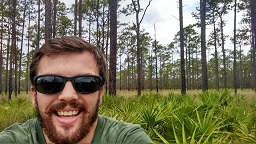flatwoods salamander recovery

My PhD dissertation at Virginia Tech focussed on conducting a population viability analysis of flatwoods salamanders.
Using information on growth and survival obtained through drift fence monitoring, I constructed integral projection models (IPMs) to estimate extinction probabilities under different management scenarios (Pop. Ecol. 2023).
To build the IPM I developed growth curves, the first of their kind, that jointly model amphibian growth before and after metamorphosis (PLoS One 2020), and survival curves that account for seasonal differences in mortality (Ichthyol. Herpetol. 2024).
Scaling up from individual populations to the landscape level, I developed one of the first spatially-explicit metapopulation models for a pond-breeding amphibian (Aquat. Conser. 2019), and investigated the importance of detectibility and genetic diversity in the context of future reintroduction efforts (PeerJ 2021, Anim. Conserv. 2023).
Ultimately, this body of work was used to aid flatwoods salamander recovery.
Publications, Talks, and Posters
Chandler, H. C., G. C. Brooks, N. M. Caruso, and C. A. Haas. 2024. Wetland hydrology, not altered phenology, challenges Reticulated Flatwoods Salamander (Ambystoma bishopi) management under future climate change. Ichthyology and Herpetology in press
Martin, A. K., G. C. Brooks, H. C. Chandler, K. C. Jones, B. K. Rincon, and C. A. Haas. 2024. Tracking Reticulated Flatwoods Salamander (Ambystoma bishopi) recovery in response to habitat restoration. Joint Meeting of Ichthyologists and Herpetologists, Pittsburg, PA, USA.
Chandler H. C., G. C. Brooks, K. Jones, B. Rincon, and C. A. Haas. 2024. Lessons learned from long-term monitoring and research of Reticulated Flatwoods Salamander (Ambystoma bishopi) populations on Eglin Air Force Base. Southeast Partners in Amphibian and Reptile Conservation Annual Meeting, Nauvoo, AL, USA.
Brooks, G. C., T. A. Gorman, and C. A. Haas. 2024. Variation in flatwoods salamander survival is unrelated to temperature and rainfall. Ichthyology and Herpetology 112:31-40. link
Brooks, G. C., H. C. Chandler, D. Z. Childs, Y. Jiao, and C. A. Haas. 2024. Predicting the population viability of an endangered amphibian under environmental and demographic uncertainty. Population Ecology 66:184-195. link
Chandler, H. C. and G. C. Brooks. 2023. The relationship between female body size and clutch size in frosted flatwoods salamanders (Ambystoma cingulatum). Southeastern Naturalist 22:588-594. link
Brooks, G. C., T. A. Gorman, K. C. Jones, H. C. Chandler, B. K. Rincon, M. A. Sission, J. Himes, and C. A. Haas. 2023. Removing duff layers in fire-suppressed wetlands can aid habitat restoration efforts. Wetlands 43:95. link
Chandler, H. C., N. M. Caruso, D. L. McLaughlin, Y. Jiao, G. C. Brooks, and C. A. Haas. 2023. Forecasting the flooding dynamics of flatwoods salamander breeding wetlands under future climate change scenarios. PeerJ 11:e16050. link
G. C. Brooks, A. Wendt, C. A. Haas, and J. H. Roberts. 2023. Comparing estimates of census and effective population size in an endangered amphibian. Animal Conservation 26:839-850. link
H. C. Chandler, N. M. Caruso, G. C. Brooks, and C. A. Haas. 2023. Reticulated flatwoods salamander phenology under future climate change. Southeast Partners in Amphibian and Reptile Conservation Annual Meeting, Black Mountain, NC, USA.
Haas, C. A., H. C. Chandler, and G. C. Brooks. 2022. Habitat restoration, sampling, and translocation planning on Eglin Air Force Base. Presentation to the Flatwoods Salamander Recovery Working Group meeting, Virtual.
Brooks, G. C. and C. A. Haas. 2021. Using historical dip net data to infer absence of flatwoods salamanders in stochastic environments. PeerJ 9:e12388. link
Brooks, G. C., Y. Jiao, T. A. Gorman, and C. A. Haas. 2020. Reconciling larval and adult sampling methods to model growth across life-stages. PLoS ONE 15:e0237737. link
Brooks, G. C., J. A. Smith, E. Frimpong, T. A. Gorman, H. Chandler, and C. A. Haas. 2019. Indirect connectivity estimates of amphibian breeding wetlands from spatially explicit occupancy models. Aquatic Conservation: Marine and Freshwater Ecosystems 29:1815-1825. link
Brooks, G. C., J. A. Smith, T. A. Gorman, and C. A. Haas. 2019. Discerning the environmental drivers of annual migrations in an endangered amphibian. Copeia 107:270-276. link
Brooks, G. C., D. C. Childs, T. A. Gorman, and C. A. Haas. 2019. Assessing population viability and the efficacy of future management scenarios for an endangered amphibian. Joint Meeting of Ichthyologists and Herpetologists, Snowbird, UT, USA.
Leipold, A. E., N. M. Caruso, G. C. Brooks, and C. A. Haas. 2019. Variations of growth within the breeding and non-breeding seasons of the Reticulated Flatwoods Salamander (Ambystoma bishopi). Annual Southeastern Partners in Amphibian and Reptile Conservation Meeting, Black Mountain, NC, USA.
Rincon, B., N. M. Caruso, G. C. Brooks, K. C. Jones, and C. A. Haas. 2019. Monitoring Reticulated Flatwoods Salamanders with PIT tag antennas: Our first season of insights. Annual Southeastern Partners in Amphibian and Reptile Conservation Meeting, Black Mountain, NC, USA.
Brooks, G. C., J. A. Smith, T. A. Gorman, and C. A. Haas. 2018. Discerning the environmental drivers of annual migrations in an endangered amphibian. Joint Meeting of Ichthyologists and Herpetologists, Rochester, NY, USA.
Brooks, G. C., J. A. Smith, E. A. Frimpong, T. A. Gorman, H. C. Chandler, and C. A. Haas. 2018. Indirect connectivity estimates of amphibian breeding wetlands from spatially explicit occupancy models. Joint Meeting of Ichthyologists and Herpetologists, Rochester, NY, USA.
Brooks, G. C., Y. Jiao, T. A. Gorman, and C. A. Haas. 2017. A novel Bayesian approach to model biphasic growth in an endangered salamander, Ambystoma bishopi. Annual Meeting of the Ecological Society of America, Portland, OR, USA.

